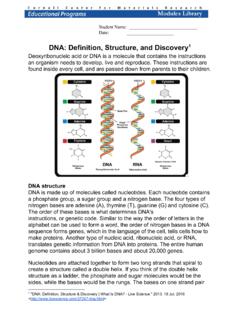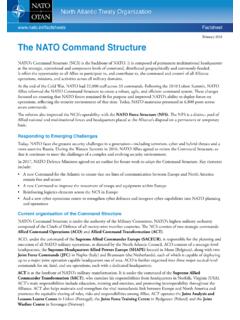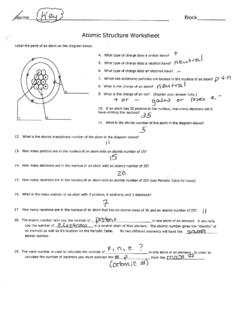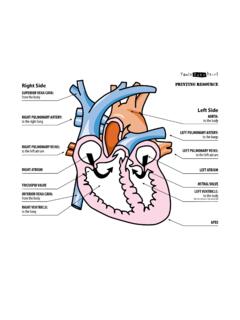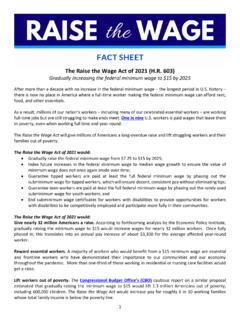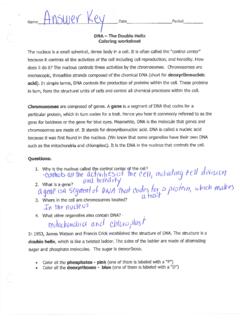Transcription of Membrane Structure and Function - Phoenix College
1 Membrane Structure and FunctionEukaryotic Cell: NeuronMembrane Structure and FunctionAll cells have a plasma or cell Membrane , which contains the cell. Scanning electron micrograph (SEM) of adipocytes(Ad) Membrane Structure and FunctionProkaryotic Cells: BacteriaThe Formation of Cell Membranes is Crucial to LifeFunctions of the Cell Membrane Contains the cell Regulates the traffic of molecules and substances in and out of the cell (semi-permeable Membrane )Cell Membrane StructurePancreatic SecretoryCell: TEM of Basal and Apical PartsMajor Components of the Cell Membrane The major constituents of the cell Membrane are proteins and lipids Membrane proteinsand lipids are arranged in a particular fashion, both contributing to containing the cell and to selectively allowing or blocking the traffic of certain substances through the cell Such arrangement of molecules provides fluidityto the cell membraneMajor Components of the Cell Membrane : Lipids Phospholipids are amphipathicmolecules (with hydrophobictails and a hydrophilichead) One of the phospholipidtails exist mostly in a transconfiguration, providing more fluidityto the Membrane Cholesterol is a rigid molecule that makes membranes less fluidCholesterolMajor Components of the Cell Membrane .
2 LipidsOne of the phospholipidtails exist mostly in a transconfiguration, providing more fluidity to the membraneCholesterol is a rigid molecule that makes membranes less fluidHow Are Phospholipids Organized in the Cell Membrane ? Phospholipids constitute two mirror-image oriented layers the lipid bilayer The hydrophilic heads are exposed to the high-content water regions, while the hydrophobic tails constitute a barrier impenetrable to almost all substanceshydrophobic tails: repel water: phospholipids: lipid bilayer makes sense makes no sense50%50% no senseMajor Components of the Cell Membrane : Membrane Proteins Membrane proteins are embedded in the fluid matrix of the lipid bilayer More than 50 types of proteins have been found in the plasma Membrane .
3 Membrane proteins determine most of the Membrane specific functions Transport proteins, enzymes and receptor proteins ( Membrane proteins that interact with other cells or molecules) include the vast majority of Membrane proteinsMajor Components of the Cell Membrane : OrganizationMajor Components of the Cell Membrane : OrganizationFunctions of the Cell Membrane Contains the cell Regulates the traffic of molecules and substances in and out of the cell (semi-permeable Membrane )Traffic of Substances Across the Plasma Membrane Selective Bidirectional Depending Upon Differences of Concentration Inside and Outside of the CellTraffic of Substances Across the Plasma Membrane Selective: only a few molecules can go through the lipid bilayer. Transport proteins mostly determine what substances cross the cell Membrane , as they carry out the majority of Membrane transportTraffic of Substances Across the Plasma Membrane Bidirectional: only a few molecules can go through the lipid bilayer.
4 Transport proteins determine what substances cross the cell Membrane . Transport can occur in/out or out/inTraffic of Substances Across the Plasma Membrane Depending Upon Differences of Concentration Inside and Outside of the Cell: Osmosisand diffusionare the two main processes by which molecules move across the cell membrane___ control the traffic of molecules through the cell Membrane Membrane proteins Lipids Membrane proteins proteins and lipidsTraffic of Substances Across the Plasma Membrane : Osmosis Osmosis is the movement of water and some small molecules through a semi-permeable membranefrom areas of low concentration of solutes to areas of high concentration of solutes Why does water move in that particular direction?Traffic of Substances Across the Plasma Membrane : Osmotic ShockTraffic of Substances Across the Plasma Membrane : Osmosis Draw a situation where the extracellularenvironment is such that water flows out of the cell Is the extracellularenvironment hypo-, hyper-, or isotonic?
5 In this situation, will water flow out of the cell? Yes No50%50% [NaCl] = mg/ml[NaCl] = mg/mlTraffic of Substances Across the Plasma Membrane : Diffusion Diffusion is the movement of substances from an area of high concentration of solutes to an area of low solute concentration (down to a concentration gradient)Traffic of Substances Across the Plasma Membrane : Diffusion Draw a situation where a molecule of NaClwill enter the cell. Assume that a transport protein is needed Is the extracellularenvironment hypo-, hyper-, or isotonic? Direction of water?In this situation, will a molecule of NaClenter the cell? Yes No50%50% [NaCl] = mg/ml[NaCl] = mg/mlTraffic of Substances Across the Plasma Membrane : Facilitated Diffusion Facilitated diffusion is a protein-mediated passive(no energy required) diffusion of molecules across the cell Membrane Transport proteins carry out facilitated diffusion; facilitated diffusion is very selective, as each transport protein transports just one type of moleculeTraffic of Substances Across the Plasma Membrane : Active Transport Active transport is a protein-mediated transport of molecules across the cell Membrane against a concentration gradient (low to high solute concentration areas).
6 It requires a boost of energy (ATP) to occur. As facilitated diffusion, is very selective Glucose is actively transported through the plasma Membrane of intestinal cellsBulk Transport of Substances Across the Plasma Membrane : Exocytosisand EndocytosisPancreatic SecretoryCell: TEMT ypes of Endocytosis: PhagocytosisIn phagocytosis( cell eating ), a cell engulfs a particle or another cell through the emission of pseudopodia, and packs it into a vacuole. The contents of the vacuole is digested after the vacuole fuses with a lysosomePhagocytosisof erythrocytes (Er) by blood macrophages (Ma).Types of Endocytosis: Pinocytosis In pinocytosis( cell drinking ), the cell takes in droplets of extracellularfluid into small vesicles. Many molecules enter the cell dissolved in the droplets in a non-specific mannerTypes of Endocytosis: Receptor-Mediated Endocytosis Receptor-mediated endocytosisrequires of specific receptor proteins located in the cell Membrane .
7 Cell receptors interact with the molecule to be transported into the cell through a ligand a molecule that binds specifically to the receptor Receptor-mediated endocytosisis highly specific. Human cells use receptor-mediated endocytosisto take in cholesterol. Some viruses ( HIV virus) enters the cell through receptor-mediated endocytosis Mutations in receptor proteins involved in receptor-mediated endocytosisusually block the entrance of substances meant to be transported by this process ( natural HIV immunity, familial hypercholesterolemia)The arrows point to a process of: receptor-mediated .. exocytosis phagocytosis33%33%33% arrows point to a process of: receptor-mediated .. exocytosis phagocytosis33%33%33%





